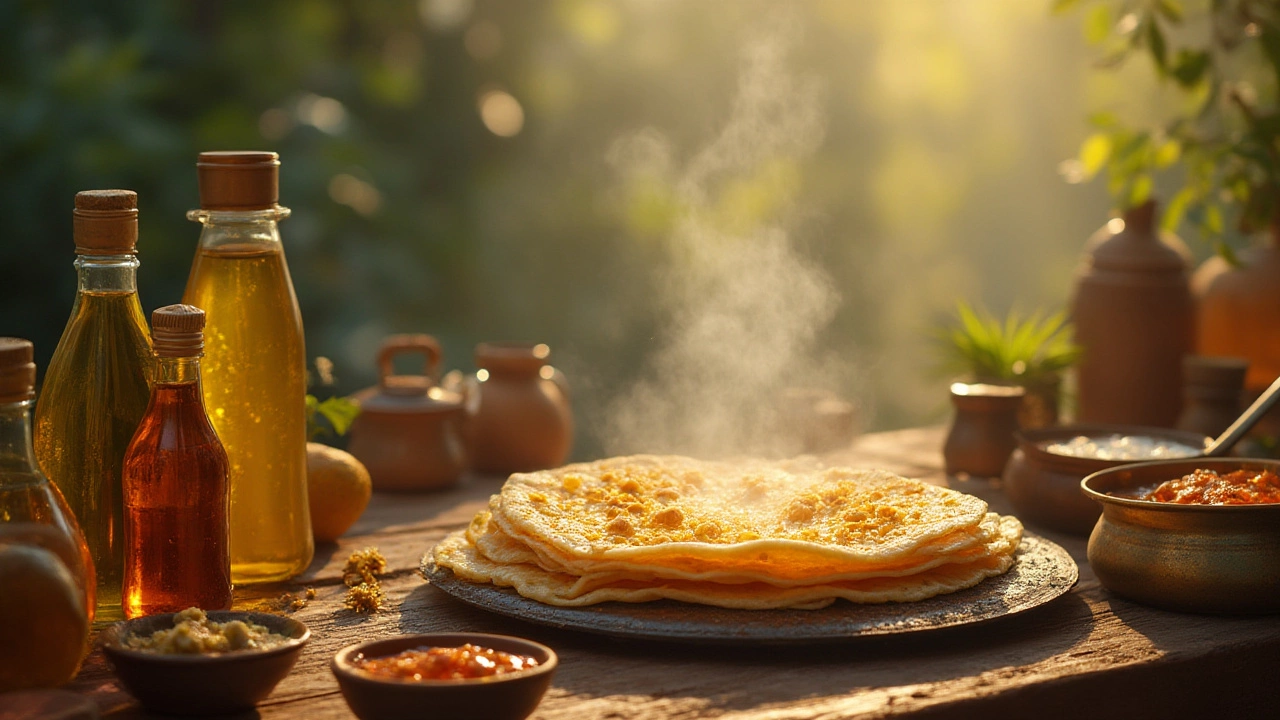Dosa Oil Types – Pick the Right Oil for Perfect Crisps
When working with dosa oil types, the variety of cooking oils you can use for frying dosas, each with its own smoke point, flavor profile, and health impact. Also known as dosa frying oils, it plays a crucial role in achieving that golden crunch and keeping the batter light. Alongside oil, dosa batter is the fermented rice‑lentil mixture that forms the base of every dosa and fermentation the biochemical process that develops flavor and texture in the batter are key players. Understanding how health benefits like improved digestion and lower glycemic impact come from proper oil and batter choices ties everything together.
First, the oil’s smoke point decides whether you’ll get a clean, even fry or a burnt edge. High‑smoke‑point oils such as refined sunflower or rice bran stay stable at the 180‑200 °C range needed for a quick sear, preserving the batter’s airy pockets. Low‑smoke‑point options like extra‑virgin olive oil may impart a pleasant aroma but risk smoking, which can make the dosa taste bitter and create unhealthy compounds. Choose the oil that matches your pan’s heat capacity, and you’ll notice a direct link: oil choice influences crispness. That simple connection is the backbone of mastering dosa texture.
How Oil Choice Interacts with Batter Fermentation
The fermentation stage decides how much air the batter traps. A well‑fermented batter (usually 8‑12 hours at room temperature) yields a light, bubbly mix that spreads thinly. When you pour this batter into a hot pan, the oil’s viscosity and flavor coat the surface, preventing sticking and encouraging the bubbles to pop into tiny crisp pockets. If you use an oil with a strong flavor—like coconut oil—it will flavor the dosa and slightly lower the surface tension, which can make the edges softer. Conversely, neutral oils let the natural sour‑sweet notes of the fermented batter shine.
Another factor is the oil’s fatty acid profile. Oils rich in monounsaturated fats, such as canola or peanut oil, not only handle high heat well but also add a subtle nutty note that complements the mild tang of a fermented batter. This synergy boosts the overall taste without overwhelming the delicate flavors. Meanwhile, saturated‑fat‑heavy oils like ghee bring richness and a buttery finish, prized in South Indian households for special occasions. Each oil type thus enhances a different aspect of the final dosa.
Nutrition also matters. A study from the Indian Council of Medical Research showed that using oils with higher omega‑3 content, like flaxseed oil (added after cooking), can improve the heart‑healthy profile of a dosa breakfast. While you can’t fry with flaxseed oil due to its low smoke point, drizzling a teaspoon over the finished dosa adds antioxidants without compromising texture. This illustrates a semantic triple: choosing the right oil enhances health benefits while preserving crispness.
Practical tips for everyday cooks: start with a small amount of oil—just enough to coat the pan—and increase only if the dosa sticks. Temperature control is key; a drop of batter should sizzle instantly but not brown in seconds. If you’re using a non‑stick pan, you can get away with less oil, but the classic iron skillet thrives with a thin film of high‑smoke‑point oil.
Seasonality can guide your oil pick too. During monsoon months, many Indian kitchens prefer coconut oil because its aroma pairs well with rainy‑day comfort foods. In summer, lighter oils like sunflower keep the dish less greasy, which many find refreshing. Recognizing when an oil matches the climate and the meal context is another semantic link: oil selection aligns with seasonal taste preferences.
Beyond the basics, you can experiment with blends. Mixing half refined sunflower with half ghee gives you a high smoke point while still delivering that traditional buttery finish. Some chefs even add a splash of sesame oil at the end for an umami boost. These hybrid approaches show that dosa oil types are not a rigid list but a flexible toolbox.
For those watching calories, spraying the pan with a mist of oil or using a silicone brush can cut down on fat without sacrificing crunch. The batter’s fermentation level becomes even more important here—stronger fermentation means more natural lift, requiring less oil to separate the dosa from the pan.
Finally, remember to store your oil properly. Light, heat, and air degrade quality, lowering smoke points over time. Keep high‑smoke‑point oils in a dark pantry, and reserve ghee or coconut oil in the refrigerator if you don’t use them often. Fresh oil maintains the intended flavor profile and keeps the health claims valid.
All these considerations—smoke point, flavor, nutrition, seasonality, and storage—form a network of decisions that directly affect how your dosas turn out. Below, you’ll find articles that dig deeper into each of these points, from quick fixes for batter fluffiness to the science behind post‑dosa sleepiness. Explore the collection to fine‑tune your oil game and elevate every bite.
Best Oils for Dosa: Choosing the Ideal Oil for Crispy, Tasty Dosas
Wondering which oil makes the crispiest dosa? Explore the best oils, their health notes, taste, and tips to achieve next-level dosas every time.
Read more